在 Controller 中我们可以使用 FileResult 向客户端发送文件。
FileResult
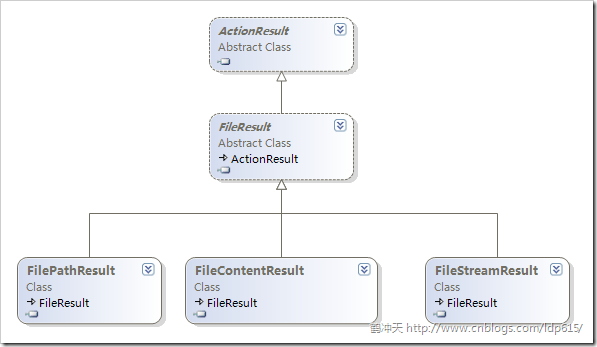
FileResult 是一个抽象类,继承自 ActionResult。在 System.Web.Mvc.dll 中,它有如上三个子类,分别以不同的方式向客户端发送文件。
在实际使用中我们通常不需要直接实例化一个 FileResult 的子类,因为 Controller 类已经提供了六个 File 方法来简化我们的操作:
protected internal FilePathResult File(string fileName, string contentType); protected internal virtual FilePathResult File(string fileName, string contentType, string fileDownloadName); protected internal FileContentResult File(byte[] fileContents, string contentType); protected internal virtual FileContentResult File(byte[] fileContents, string contentType, string fileDownloadName); protected internal FileStreamResult File(Stream fileStream, string contentType); protected internal virtual FileStreamResult File(Stream fileStream, string contentType, string fileDownloadName);
FilePathResult
FilePathResult 直接将磁盘上的文件发送至浏览器:
1. 最简单的方式
public ActionResult FilePathDownload1()
{
var path = Server.MapPath("~/Files/鹤冲天.zip");
return File(path, "application/x-zip-compressed");
}
第一个参数指定文件路径,第二个参数指定文件的 MIME 类型。
用户点击浏览器上的下载链接后,会调出下载窗口:

大家应该注意到,文件名称会变成 Download1.zip,默认成了 Action 的名字。我们使用 File 方法的第二个重载来解决文件名的问题:
2. 指定 fileDownloadName
public ActionResult FilePathDownload2()
{
var path = Server.MapPath("~/Files/鹤冲天.zip");
return File("g:\\鹤冲天.zip", "application/x-zip-compressed", "crane.zip");
}
public ActionResult FilePathDownload3()
{
var path = Server.MapPath("~/Files/鹤冲天.zip");
var name = Path.GetFileName(path);
return File(path, "application/x-zip-compressed", name);
}
我们可以通过给 fileDownloadName 参数传值来指定文件名,fileDownloadName 不必和磁盘上的文件名一样。下载提示窗口分别如下:
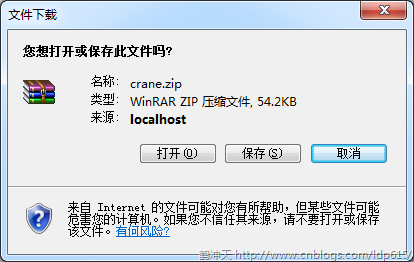
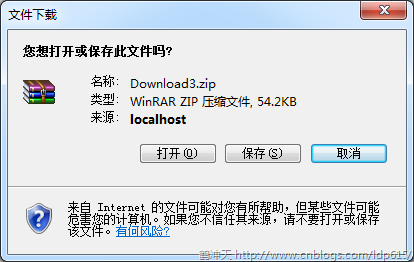
FilePathDownload2 没问题,FilePathDownload3 还是默认为了 Action 的名字。原因是 fileDownloadName 将作为 URL 的一部分,只能包含 ASCII 码。我们把 FilePathDownload3 改进一下:
3. 对 fileDownloadName 进行 Url 编码
public ActionResult FilePathDownload4()
{
var path = Server.MapPath("~/Files/鹤冲天.zip");
var name = Path.GetFileName(path);
return File(path, "application/x-zip-compressed", Url.Encode(name));
}
再试下,下载窗口如下:

好了,没问题了。上面代码中 Url.Encode(…),也可使用 HttpUtility.UrlEncode(…),前者在内部调用后者。
我们再来看 FileContentResult.
FileContentResult
FileContentResult 可以直接将 byte[] 以文件形式发送至浏览器(而不用创建临时文件)。参考代码如下:
public ActionResult FileContentDownload1()
{
byte[] data = Encoding.UTF8.GetBytes("欢迎访问 鹤冲天 的博客 http://www.cnblogs.com/ldp615/");
return File(data, "text/plain", "welcome.txt");
}
点击后下载链接后,弹出提示窗口如下:

FileStreamResult
想给 FileStreamResult 找一个恰当的例子是不太容易的,毕竟 Http Response 中已经包含了一个输出流,如果要动态生成文件的话,可以直接向这个输出流中写入数据,效率还高。当然,我们不会在 Controller 中直接向 Response 的 OutputStream 写入数据,这样做是不符合MVC的,我们应该把这个操作封装成一个 ActionResult。
不过仔细想想,用途还是有的,比如服务器上有个压缩(或加密)文件,需要解压(或解密)后发送给用户。
1. 解压(或解密)
演示代码如下,解压使用 ICSharpCode.SharpZipLib.dll:
public ActionResult FileStreamDownload1()
{
var path = Server.MapPath("~/Files/鹤冲天.zip");
var fileStream = new FileStream(path, FileMode.Open);
var zipInputStream = new ZipInputStream(fileStream);
var entry = zipInputStream.GetNextEntry();
return File(zipInputStream, "application/pdf", Url.Encode(entry.Name));
}
简单起见,假定压缩文件中只有一个文件,且是 pdf 格式的。鹤冲天.zip 如下:
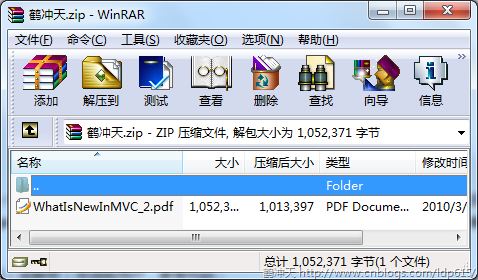
点击后弹出下载提示窗口如下:
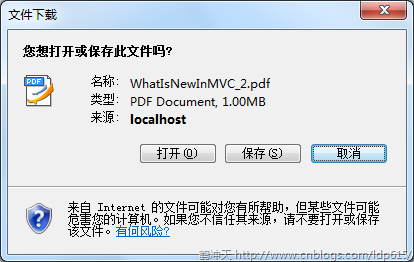
2. 转发(或盗链)
FileStreamResult 的另一种用途是将其它网站上的文件作为本站文件下载(其实就是盗链):
public ActionResult FileStreamDownload1()
{
var stream = new WebClient().OpenRead("http://files.cnblogs.com/ldp615/Mvc_TextBoxFor.rar");
return File(stream, "application/x-zip-compressed", "Mvc_TextBoxFor.rar");
}
看下面提示窗口,来源还是 localhost:




